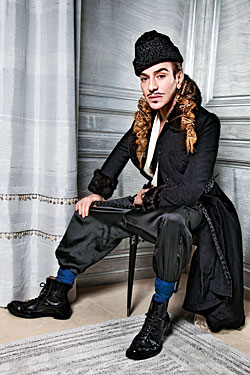John Galliano
 |
(Photo: Roxanne Lowit) |
What does John Galliano wear for an afternoon in New York? Heavy Swiss hiking boots, black long johns, enormous silk boxer shorts printed with the image of a tiger, a belted military jacket, and a jaunty Tyrolean cap. His hair in two long, nappy braids made flat by hundreds (thousands?) of pins, a carefully pruned goatee on his chin, a well-defined little mustache across the top of his lip.
He was here for the reopening of Dior’s 57th Street boutique, designed by architect Peter Marino—who himself dresses in a rotation of leather motorcycle gear featuring suspenders and police caps, chaps, and tiny little vests—and he was staying at the Mercer Hotel. On Galliano’s floor, the air was scented with his signature Diptyque candle (pine, spicy orange, something called “Oliban”), and a waiter stood silently offering all sorts of drinks, like Champagne, but also John’s Tea, which is a Mariage Frères blend of green and black. One publicist (handsome, French) hovered nearby, while another (beautiful, American) waited just outside the door while Galliano gave an interview, smiling and purring like a cat marooned in a puddle of sun and milk.
Within the fashion world, there are only a very few people in this day and age who have reached Galliano’s level of fame—Karl Lagerfeld comes to mind. When it happens, it’s as if the image and the actual person become almost impossible to detangle. Their celebrity is, in a way, purer than an actor’s, because it is not based on bringing someone else’s imagination to life; it is based on embodying the designer’s own.
Galliano’s visit to New York coincided with his fourteenth anniversary at the House of Dior, a tenure that has been—considering the extremism of his persona—without much drama, aside from the elaborate bows (smoke machines, violet gels on the light, mountains of dry ice) he takes at the end of his shows. When he started, he came across as a wild London club kid, but he has turned out to be someone suited not only to the demands of the haute-couture atelier but also to the challenge of globalizing an old-fashioned French brand.
Do you feel an affinity for Mr. Dior?
He was a gardener, I am a gardener. He loved to grow flowers, and I see myself pruning them. I love women, I love beauty, we are both romantics, we have similar sensibilities. I love innovation, he loved innovation. I feel very comfortable. It’s not something that I have to force or that’s too studied or preconceived. It all happens quite naturally.
What do you look at when you walk the streets of New York? Do you find inspiration here?
I walk down the street in whatever city I’m in, and I’m really very open to life. It’s easy to find beauty. I’m looking for that next new elusive muse that I will hinge my narrative on and create a collection around. Something goes on with the intuitive side of my brain, and it’s put into order by the logical side.
So who is the muse this time?
She’s always elusive. I’m always chasing her. She’s an essence, a spirit. Like a parfum. I don’t really ever want to catch her because that’s what keeps me going.
You aren’t the designer who dresses in black and disappears next to his creations.
It’s very simple. I immerse myself so deeply in my narrative and my research—and it would happen to you too, by the way—that this muse becomes a part of you, and of course it has an effect on the way you look, the way you speak, the way you move. You’re imagining the color of crimson on her lips. Do you smell gin on her breath? Does she write by candlelight? I’m living that character day and night whatever collection it is.
So it takes you over a bit?
It really does. Totally. Last season at Galliano was a tortured artist inspired by Modigliani, and I’m still smoking Gitanes. And sniffing absinthe because I was living it, breathing it.
So is this look—the long johns, the cap—related to your new muse?
This is just John. John in New York. I love dressing up, yes I do. I think it’s polite

Comments
Post a Comment